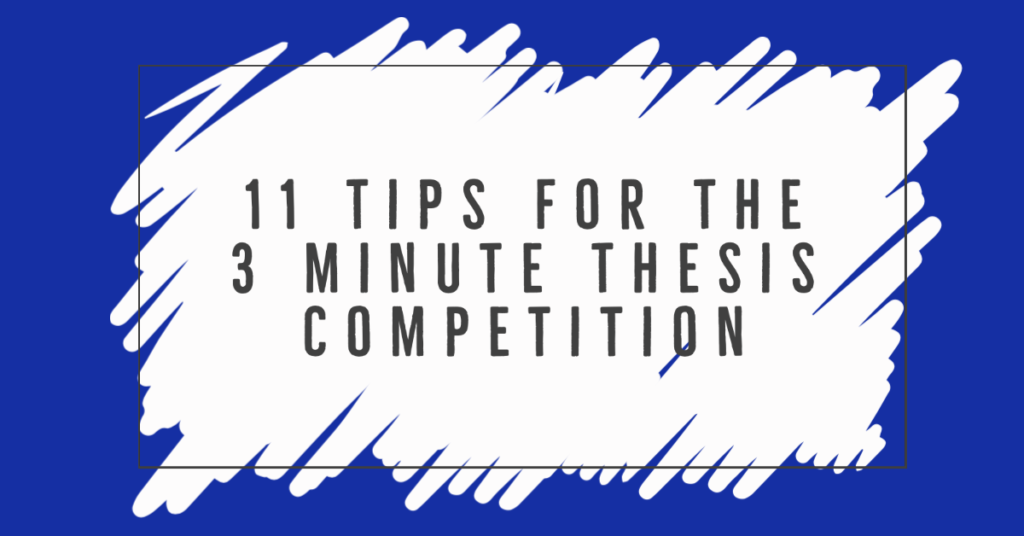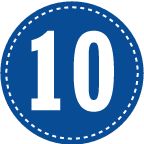Funny End of Presentation Slides in Cancer

After coaching both the Three Minute Thesis (3MT) and 3-minute post doc competitions at the University of Buffalo, here are my 10 tips for taking 1stplace in the competition:

Start with "Why," end with "Why."
As researchers interacting with our peers, we develop a methods-centric style of speaking. This style is based on the assumption that the person you are speaking with already understands the larger context of your research, an assumption which is often incorrect when speaking to a layperson. Instead, start by explaining the problems you are solving so the significance of your work can be clearly understood. Then, end your talk by reiterating this point and offer a "vision of the future" – a world which is different (presumably better) because of your work today.

Lose the details.
There is no such thing as a research subject that is too boring or obscure for 3MT. It's the challenge of this competition that you must find what is interesting and exciting about your work and convey it succinctly. This information should be in your opening lines so you can hook the audience in. Many students will instinctively start by offering a detailed lecture on their research subject, citing case numbers and describing mechanisms – this is guaranteed to confuse the layperson who will be unable to put these facts and figures into their pre-existing understanding of the world. Start with broad, accessible ideas, work slowly towards the general details of your work, and then finish with more broad, accessible ideas. It should be apparent to the audience at every point what you are saying and why it makes sense. This will make the listener feel all the smarter for having understood you and, consequently, they will be excited for your research.

Tell a story.
You are the storyteller. You need to enthrall your audience so they can understand your research and its significance. Use drama to your advantage. Establish the scene and present the struggle which your research hopes to understand or resolve. A brilliant example of this comes from a student I coached for the 2018 3MT finals at UB, Camila Consiglio, in her talk on sex difference in immune responses. She begins by explaining healthy immunity as a finely tuned "thermostat." As she explains, "a healthy immune system is strong enough to fight infections and prevent the development of cancer but not so strong that it can attack the body." She then points out an unexpected finding: "Men are thought to be the stronger sex… but, when it comes to immune responses, men have weaker immune responses and develop more cancer and more infections than women… And women have too strong of an immune response and they develop autoimmunity." These contrasting ideas of strength vs weakness in immunity between men and women creates a dramatic tension: "why does immunity differ between the sexes?" She then excitedly resolves the tension, saying that "the hand which controls the thermostat is sex hormones." However, this leads to a new mystery: "which sex hormones? And how do they influence immunity?" The cycle of posing and answering questions through research keeps the listener interested and engaged throughout the remainder of the talk. In my experience, most science-based 3MT talks can implement a similar pattern to enthrall the listener with their research.

The PowerPoint slide is a trap. Do not fall for it.
The PowerPoint slide has long been the downfall of 3MT competitors because it plays upon the most basic instinct of the researcher: the desire to convey complex technical information in PowerPoint form. You must resist this urge. Watch the international 3MT competition – notice that the finalists have little or no information on their slides. That is because they know that, in 3MT, the speaker is the ultimate source of information. When a slide is overloaded with information (especially any significant amount of text), it is a distraction from the speaker. A typical slide on a winning presentation uses the slide to set a mood or tone or to convey a main talking point from which the speech draws upon. An example of this can be found in the slide used by another student I coached, Naila Sahar, in her talk on the contradictions between depiction and reality for Muslim women. Her PowerPoint shows 6 prominent Muslim women who have been depicted as deranged or downtrodden by various media sources. She points out the stark contrast between these "false narratives" and the reality of their inner strength and great accomplishments. The noble and dignified images of these women highlight this point succinctly.

Use The Slide As A Prop.
Additionally, some speakers use their slide as a prop in their talk. My favorite example of this comes from another student I coached, Anne Marie, in her presentation for the 2018 3MT finals at UB. She uses the slide to present a complex and confusing work of modern art in order to generate dramatic tension and mild discomfort for the listener. But, as she talks, the audience actively gains great appreciation for the art and comes to understand its value.

Take the listener on a journey.
Good 3MT talks are interesting. Great 3MT talks are a revelation. The former conveys ideas to the listener. The latter transforms the listener's world view. I again return to Anne Marie's 3MT talk. She challenges the listener's preconceived notions about modern art, teaches them to understand and appreciate it like she does, and, by the end, the listener has embodied a new outlook on art which will serve them for the rest of their lives. Another superb example comes from another student I coached, Philip Odonkor, with his 1st place 3MT talk on his research in electrical sensors. His provocative title, "Is your house smarter than a mud hut?," encapsulates his challenge to the listener: to recognize that, despite our immense technological advances, our homes are typically as "dumb" as a mud hut. He paints a vision of the future for his audience in which they see themselves living a life of pampered luxury in their smart home. By the end of his talk, the listener believes deeply in the future Phil's research will create.

Breathe and speak slowly.
Every time you practice your speech, take a few seconds to breathe deeply before you begin. In the competition, the clock does not start until you begin speaking – so you have time to catch your breath and center yourself. If you practice breathing every time, you will remember to do it when you are in the real competition. Also speak slowly – about 50%-65% of your typical speaking speed. In the competition, you will speed up naturally because of anxiety. If you have practiced talking slowly, then you will not speed up too much when under pressure. Additionally, you may forget a line or stumble during the competition. If you have given yourself plenty of breathing room, you can take a moment to re-center without any fear of going overtime.

Don't tell.
An interesting facet of human learning: we are generally much better at understanding and retaining visual information than information which we hear. If you want to win 3MT, the audience has to see your ideas, not just hear them. That is why the restriction to one slide is there – it forces you to make people see your ideas using only your words, your tone, and your body language. Once you have a final script for your talk, start styling it. Techniques you can easily employ involve pausing, speeding up/slowing down, and getting louder/quieter. These verbal cues add a layer of additional context that helps your audience understand the picture you are painting. Additionally, use your body language to indicate concepts. Your hands and the orientation of your face are the strongest cues. Phil's 3MT talk is again a wonderful example of all these techniques executed masterfully. At one point, he says "make sense of the world around them, and the people living within". On the word "around" he gestures in a wide circle with his hands and then on the syllable "-in" he brings them back into his chest. While the audience is unlikely to consciously notice the motions, they are painting a deeply vivid picture all the same. Again, notice the hands as he says "as you crawl out of bed, the light automatically adjusts to complement the natural light coming in" – for each of the italicized words in that sentence, Phil essentially mimed out the concept using his hands and head orientation. See if you can find ways to similarly mime out aspects of your speech as well.

Practice. Win.
Some of you might be thinking you can speak extemporaneously and win 3MT. Think again. A great 3MT presentation combines three layers: (1) the words, (2) the way in which the words are spoken, and (3) the gestures and facial expressions used to help convey meaning. All three must be polished. The words and tone can both be polished by speaking them aloud, recording yourself, and playing it back so you can adjust. When you feel the urge to say "Um" or "Uh", pause instead. The facial expressions and gestures can be practiced in the mirror or by video recording yourself. In my experience, before you can truly master the tone, timing, and gestures, the words must be committed to memory entirely. Then, once you have your final words, speaking style, and gestures, you can begin to practice over and over until you can consistently do your speech perfectly within the target time limit. 3MT winners often practice at least 50 times over the span of several days before the competition.

Stand on the shoulders of giants.
Watch previous year's 3MT finals at Queensland University. Emulate aspects of these talks which you like within your own speech. TED talks are another great resource (though few are 3 minutes or less). Additionally, check out great books such as Simon Sinek's "Start with Why" and Chris Anderson's "TED Talks: The Official Guide to Public Speaking". I have personally read both books and found them to be immensely valuable resources for prepping for competitions like 3MT.

Have fun.
Remember that you have the opportunity in 3MT to tell your audience about your awesome, exciting research so they can get just as jazzed up about it as you are. Ultimately you are giving them a gift, one that will improve their lives and bring them the joy which comes with learning something new and understanding something complex. A strategy employed by many professional presenters before they begin to speak is to say to themselves "I love my audience, and they love me". While perhaps a bit egotistical, such rituals are centering for 3MT presenters too because it helps them get into the right headspace: you are here to give the gift of knowledge and understanding, so your audience is going to enjoy hearing your talk and learning about your research.
While 3MT can feel daunting and scary, the simple act of participating and doing your best will make you a better scientist and communicator regardless of whether you win. Also, do not forget that there are many resources to get help if you want it. You can schedule an appointment to speak with me by emailing me at millerh1@livemail.uthscsa.edu and there are many resources available online for learning the skills to win 3MT such as those provided by Queensland University.
Best of luck!
About The Author
 Henry Miller is a student in the Biology of Aging discipline of the Integrated Biomedical Sciences (IBMS) program at UT Health San Antonio. He uses computational biology to answer fundamental questions about how Ewing sarcoma develops in patients.
Henry Miller is a student in the Biology of Aging discipline of the Integrated Biomedical Sciences (IBMS) program at UT Health San Antonio. He uses computational biology to answer fundamental questions about how Ewing sarcoma develops in patients.
Source: https://pipettegazette.uthscsa.edu/2020/08/21/10-tips-for-3-minute-thesis-competition/
0 Response to "Funny End of Presentation Slides in Cancer"
Post a Comment